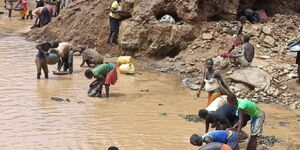The recent cases of two landslides occurring in Elgeyo Marakwet over a three-day period have sparked alarm, with over 20 deaths being reported and many others still to be found.
The first occurred in the wee hours of Saturday, November 1, in Moror Village and Chesongoch Centre following a night of heavy rains. Two days later, another landslide hit Kipkenda Village, Kibendo, Emsoo Ward, Keiyo North, still in Elgeyo Marakwet, with rescue operations underway at the time of publishing this article.
But what causes a landslide? And can it be prevented? By definition, a landslide is the movement of rock, earth, or debris down a sloped section of land.
Landslides are caused by rain, earthquakes, volcanoes, or other factors that make the slope unstable. When the force of gravity acting on a slope exceeds the resisting forces of the slope, the slope will fail, and a landslide will occur.
Rain, as was the case in the Elgeyo Marakwet landslides, is the most common cause of landslides. In the rain-induced landslide, water seeps into the ground, adding significant weight to the slope, increasing the pressure, and reducing the friction and internal strength of the soil and rock.
Landslide vs Mudslide
This can lead to rapid-moving mudflows or debris flows, especially in areas with little vegetation. In the two recent cases, however, a great argument could be made that what was experienced was a mudslide.
In broader terms, all mudslides are landslides, but not all landslides are mudslides. While landslides are a general, overarching term for any movement of a mass of rock, soil, or debris down a slope under the influence of gravity, a mudslide, more accurately referred to as a debris flow by geologists, is a specific, fast-moving type of landslide that involves a large amount of water.
A mudslide is primarily composed of water-saturated soil and fine sediment (mud), but can also carry larger items like boulders, trees, and cars. It requires a high degree of water saturation to flow like a liquid and is often triggered by intense rainfall or rapid snowmelt.
Mudslides are highly tragic, as they are always fast-moving, often striking with little to no warning and capable of travelling at speeds of 56 kilometers per hour or more.
With this information, the Elgeyo Marakwet tragedies could be classified as mudslides, but it is still right to call them landslides, as they have the general characteristics of the geographical phenomenon.
Forms of Landslides
Away from this, landslides take different forms depending on slope and movement. Falls happen on steep slopes when rocks or debris break off and collect at the base, while topples involve material rotating forward and falling outward around a pivot point near the slope’s base.
Slides occur when material moves along a slip surface below the ground. They can be rotational, with a curved surface causing a slump-like motion, or translational, where movement happens along a flat plane such as a fault or bedding layer, often moving quickly and causing major damage.
Flows involve water or another fluid mixing with loose material to form a fast-moving slurry of mud, debris, or rock that moves like a liquid.
How to Prevent Landslides
For prevention, landslides can be prevented through the construction of safe steep slopes, installation of surface drainage, and repair of failed slopes. For surface drainage, it works to reroute surface water away from a slope, thus reducing the likelihood of a landslide.
In high rainfall areas, erosion protection via surface drainage, both at the toe and on the surface, can be very effective, positively impacting the maintenance of the angle of the slope.
In constructing safe steep slopes, they can be made stable and prevent landslides by the inclusion of soil reinforcement in the form of high-strength geogrids. Still, the easiest way to prevent landslides is to avoid building in areas prone to landslides.












